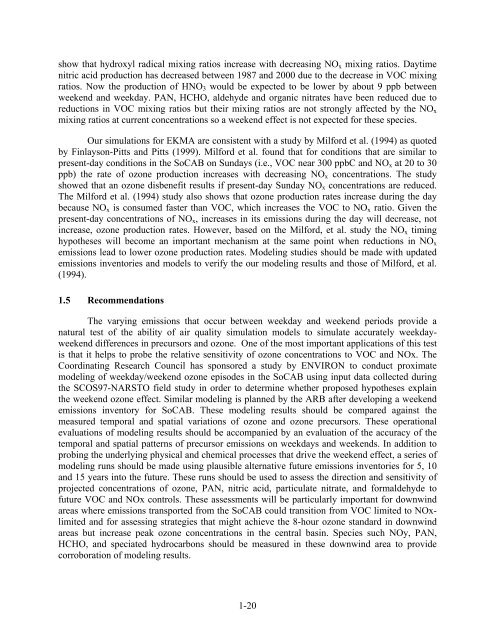Weekend/Weekday Ozone Observations in the South Coast Air Basin
Weekend/Weekday Ozone Observations in the South Coast Air Basin
Weekend/Weekday Ozone Observations in the South Coast Air Basin
You also want an ePaper? Increase the reach of your titles
YUMPU automatically turns print PDFs into web optimized ePapers that Google loves.
show that hydroxyl radical mix<strong>in</strong>g ratios <strong>in</strong>crease with decreas<strong>in</strong>g NO x mix<strong>in</strong>g ratios. Daytime<br />
nitric acid production has decreased between 1987 and 2000 due to <strong>the</strong> decrease <strong>in</strong> VOC mix<strong>in</strong>g<br />
ratios. Now <strong>the</strong> production of HNO 3 would be expected to be lower by about 9 ppb between<br />
weekend and weekday. PAN, HCHO, aldehyde and organic nitrates have been reduced due to<br />
reductions <strong>in</strong> VOC mix<strong>in</strong>g ratios but <strong>the</strong>ir mix<strong>in</strong>g ratios are not strongly affected by <strong>the</strong> NO x<br />
mix<strong>in</strong>g ratios at current concentrations so a weekend effect is not expected for <strong>the</strong>se species.<br />
Our simulations for EKMA are consistent with a study by Milford et al. (1994) as quoted<br />
by F<strong>in</strong>layson-Pitts and Pitts (1999). Milford et al. found that for conditions that are similar to<br />
present-day conditions <strong>in</strong> <strong>the</strong> SoCAB on Sundays (i.e., VOC near 300 ppbC and NO x at 20 to 30<br />
ppb) <strong>the</strong> rate of ozone production <strong>in</strong>creases with decreas<strong>in</strong>g NO x concentrations. The study<br />
showed that an ozone disbenefit results if present-day Sunday NO x concentrations are reduced.<br />
The Milford et al. (1994) study also shows that ozone production rates <strong>in</strong>crease dur<strong>in</strong>g <strong>the</strong> day<br />
because NO x is consumed faster than VOC, which <strong>in</strong>creases <strong>the</strong> VOC to NO x ratio. Given <strong>the</strong><br />
present-day concentrations of NO x , <strong>in</strong>creases <strong>in</strong> its emissions dur<strong>in</strong>g <strong>the</strong> day will decrease, not<br />
<strong>in</strong>crease, ozone production rates. However, based on <strong>the</strong> Milford, et al. study <strong>the</strong> NO x tim<strong>in</strong>g<br />
hypo<strong>the</strong>ses will become an important mechanism at <strong>the</strong> same po<strong>in</strong>t when reductions <strong>in</strong> NO x<br />
emissions lead to lower ozone production rates. Model<strong>in</strong>g studies should be made with updated<br />
emissions <strong>in</strong>ventories and models to verify <strong>the</strong> our model<strong>in</strong>g results and those of Milford, et al.<br />
(1994).<br />
1.5 Recommendations<br />
The vary<strong>in</strong>g emissions that occur between weekday and weekend periods provide a<br />
natural test of <strong>the</strong> ability of air quality simulation models to simulate accurately weekdayweekend<br />
differences <strong>in</strong> precursors and ozone. One of <strong>the</strong> most important applications of this test<br />
is that it helps to probe <strong>the</strong> relative sensitivity of ozone concentrations to VOC and NOx. The<br />
Coord<strong>in</strong>at<strong>in</strong>g Research Council has sponsored a study by ENVIRON to conduct proximate<br />
model<strong>in</strong>g of weekday/weekend ozone episodes <strong>in</strong> <strong>the</strong> SoCAB us<strong>in</strong>g <strong>in</strong>put data collected dur<strong>in</strong>g<br />
<strong>the</strong> SCOS97-NARSTO field study <strong>in</strong> order to determ<strong>in</strong>e whe<strong>the</strong>r proposed hypo<strong>the</strong>ses expla<strong>in</strong><br />
<strong>the</strong> weekend ozone effect. Similar model<strong>in</strong>g is planned by <strong>the</strong> ARB after develop<strong>in</strong>g a weekend<br />
emissions <strong>in</strong>ventory for SoCAB. These model<strong>in</strong>g results should be compared aga<strong>in</strong>st <strong>the</strong><br />
measured temporal and spatial variations of ozone and ozone precursors. These operational<br />
evaluations of model<strong>in</strong>g results should be accompanied by an evaluation of <strong>the</strong> accuracy of <strong>the</strong><br />
temporal and spatial patterns of precursor emissions on weekdays and weekends. In addition to<br />
prob<strong>in</strong>g <strong>the</strong> underly<strong>in</strong>g physical and chemical processes that drive <strong>the</strong> weekend effect, a series of<br />
model<strong>in</strong>g runs should be made us<strong>in</strong>g plausible alternative future emissions <strong>in</strong>ventories for 5, 10<br />
and 15 years <strong>in</strong>to <strong>the</strong> future. These runs should be used to assess <strong>the</strong> direction and sensitivity of<br />
projected concentrations of ozone, PAN, nitric acid, particulate nitrate, and formaldehyde to<br />
future VOC and NOx controls. These assessments will be particularly important for downw<strong>in</strong>d<br />
areas where emissions transported from <strong>the</strong> SoCAB could transition from VOC limited to NOxlimited<br />
and for assess<strong>in</strong>g strategies that might achieve <strong>the</strong> 8-hour ozone standard <strong>in</strong> downw<strong>in</strong>d<br />
areas but <strong>in</strong>crease peak ozone concentrations <strong>in</strong> <strong>the</strong> central bas<strong>in</strong>. Species such NOy, PAN,<br />
HCHO, and speciated hydrocarbons should be measured <strong>in</strong> <strong>the</strong>se downw<strong>in</strong>d area to provide<br />
corroboration of model<strong>in</strong>g results.<br />
1-20
















